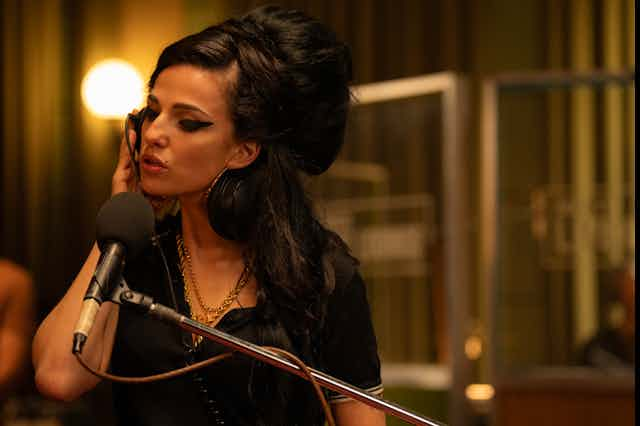When Amy Winehouse died at the age of 27 in 2011, many felt the world had been robbed of one its greatest stars who had barely shown us the extent of her talent. The new biopic Back to Black – directed by Sam Taylor-Johnson and named after Winehouse’s seminal second album – attempts to make sense of her tumultuous life and musical output.
The film follows Winehouse – played by Marisa Abela – from the early days of her career in early-2000s London, through to global stardom. In the process, it reveals the ways in which female celebrities are objectified in contemporary media and celebrity culture, even after their death.
At the height of Winehouse’s fame, gossip tabloids still ruled the media. They created what became known as “trainwreck celebrities” – predominantly female stars who were portrayed as publicly promiscuous and frequently intoxicated. The most famous from this period include Britney Spears, Lindsay Lohan, Paris Hilton and Lily Allen. These female celebrities were regularly shamed in the tabloid and gossip press on both sides of the Atlantic.
Winehouse shot to fame with her first album, Frank, in 2003, and was quickly considered one of these “trainwrecks” for being outspoken, performing intoxicated, and stumbling out of north London bars with her on-off lover and future husband, Blake Fielder-Civil.
Throughout her life, Winehouse tried to resist this form of control and commodification. She was seen fighting with paparazzi and resisting rehab when her record company tried to get her help (she even wrote a song about it).
Abela’s ability to imitate Winehouse’s voice and mannerisms is often impressive. However, while in the early stages Back to Black tries to counteract Winehouse’s tabloid image, it ultimately fails to shift this widely accepted narrative surrounding her chaotic lifestyle.
Amy’s distinct style
The beginning of the film centres on Winehouse’s songwriting talent and musical performance, which is swiftly followed by the offer of a record contract.
Abela’s Winehouse doesn’t tire of reminding her family and the viewer that she’s not in this for the fame or money. Indeed, the film both begins and ends with her telling us that all she wants is to make music that helps people forget their troubles, and only wants to be remembered for being a singer and for being herself.
Winehouse’s distinctive personal style is central to the visual storytelling of the film. The singer became known for her trademark beehive and eyeliner, as well as a signature Fred Perry polo and skinny jeans combination. She was also known for wearing pink satin ballet flats, which gained notoriety in paparazzi photos that showed them bloodied in the public aftermath of a fight with her husband in August 2007.
The film uses Winehouse’s distinctive style to communicate changes in her health. Instead of showing the unglamorous and often visually disturbing realities of bulimia and drug abuse, the progressively more torn clothes and dishevelled hair come to signify Winehouse’s physical and mental decline.
Many of these style moments used in the film were not inspired by looks she wore in her performances, but instead were captured through paparazzi footage. While the use of these visuals amid the dramatised scenes serve as a reminder of the relentless media chase Winehouse had to endure, the film ultimately reinforces this sense of media exploitation.
Rather than offering a complex visual portrayal that goes beyond the “trainwreck” images the viewer may be familiar with, Back to Black almost banks on how recognisable they are. It relies on the tabloid media’s damaging visual narrative instead of venturing to create its own.
Victim narratives
As a biopic, the film attempts to reclaim Winehouse from the victimhood often ascribed to her. However, the story it tells reduces Winehouse’s complex character and her life to a series of episodes of suffering.
Take a scene set in the wake of her beloved grandmother’s illness and death. Winehouse’s husband is presented as the villain who exploits her trauma as a moment of weakness, to introduce her to the same hard drugs she rejected early on in the film. This sets Back to Black’s story on a familiar trajectory.
In the film, her bulimia happens in the background, with scenes briefly showing Winehouse in front of the toilet. The only somewhat explicit discussion of it appears when her flatmate complains about the flushing noises that wake her up.
These brief moments serve as markers of unhappiness, but offer no exploration of where this unhappiness may come from. They eschew the complexity of Winehouse and her mental health, and don’t offer more than the shallow broken artist shaped by tragedy and the love of a bad man – a narrative we already know.
When Back to Black does look for causes of unhappiness, it settles on odd territory. At one point, it seems to suggest that her suffering stems from an unfulfilled desire to be a mother – a take that has garnered deserved criticism.
Ultimately, Back to Black is unable to capture what made Winehouse so special: the grain of her voice, and her ability to craft stories of female experience that reject simplistic narratives of suffering.

Looking for something good? Cut through the noise with a carefully curated selection of the latest releases, live events and exhibitions, straight to your inbox every fortnight, on Fridays. Sign up here.

